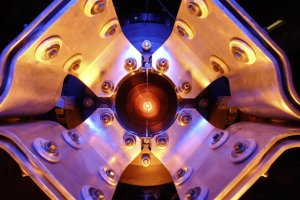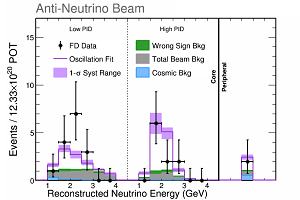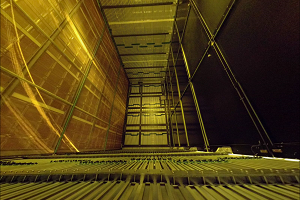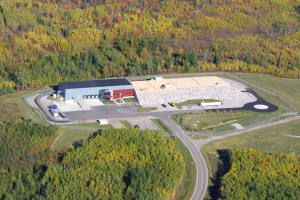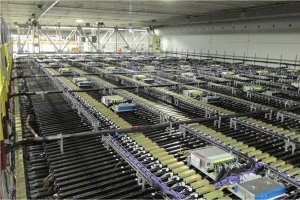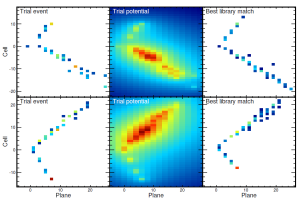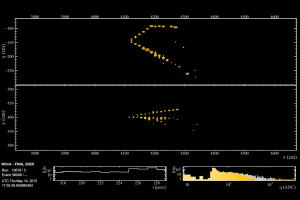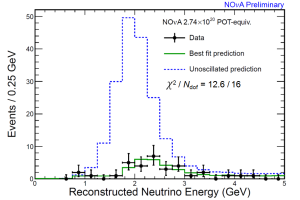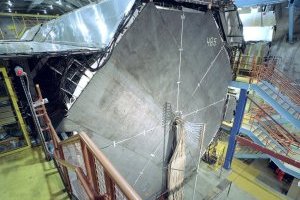 Ryan Patterson
Ryan Patterson
Professor of Physics California Institute of Technology |
rbpatter at caltech.edu 626-395-5753 Lauritsen 339 MC 356-48 HEP California Institute of Technology Pasadena, CA 91125 |
The discovery that neutrinos have non-zero mass has brought with it new complexity in the neutrino sector as well as a host of possible new phenomena in particle physics, astrophysics, and cosmology. As we explore this new complexity, many questions arise. Why does neutrino mixing look so different than quark mixing? Are maximal mixings present, and if so, what underlying symmetries cause this? What mechanism drives the smallness of the neutrino masses, and what does it imply about physics at ultra-high energy scales? Do neutrinos violate the combined charge/parity (CP) symmetry, and is this violation large enough to produce the universe we observe today – a universe full of matter but not antimatter?
My current research focuses on the neutrino sector of particle physics, addressing questions of weak mixing, neutrino masses, CP violation, and physics beyond the Standard Model. One piece of this is the currently operating NOvA experiment, a long-baseline neutrino oscillation experiment situated along Fermilab's NuMI neutrino beam. The broad physics program we are carrying out with NOvA includes: determining the ordering of the neutrino masses; constraining the phase δ of the PMNS matrix in search of leptonic CP violation; elucidating the flavor structure of neutrinos, in particular providing a leap in precision on whether the ν3 state is maximally mixed and, if it is not, determining whether the μ or τ flavor dominates; and providing new precision on the dominant "atmospheric" oscillation parameters |Δm232| and θ23. This program is supplemented by a range of both bread-and-butter and exotic measurements: neutrino-nucleus scattering, dark matter searches, supernova neutrinos, monopole searches, and more.
Nature can choose to make leptonic CP violation or non-maximal ν3 mixing arbitrarily hard to discover through careful parameter tuning, and some degeneracies can remain after NOvA if the CP phase lies in an unfavorable range. In more favorable cases, definitive CPv observation and precision measurements of PMNS mixing parameters still require a new experiment. My group is actively involved in the development of the next-generation DUNE experiment through which we are pursuing an ambitious physics program including an improved neutrino mass hierarchy measurement regardless of other parameter values; observation of leptonic CP violation at >5σ for 50% of parameter space; world-leading supernova neutrino observation capabilities, particularly (and uniquely) in the νe channel; and a wide range of searches for physics beyond the Standard Model, including baryon number violation. We have built and operated a single-phase liquid argon prototype detector (ProtoDUNE-SP) at CERN, and Far Detector site preparation is underway.
I was previously involved in the the MINOS long-baseline experiment, which completed data taking in 2012. In MINOS, I focused on θ13-driven νe appearance and on searches for new physics through comparisons of neutrino and antineutrino oscillations. Further back in time I was involved in the MiniBooNE program, with the primary goal of testing the unexpected LSND evidence for νμ→νe transitions at high apparent Δm2.
Members of the group
| Alejandro Diaz | [ Postdoctoral Scholar ] | ||
| Leon Mualem | [ Research Scientist ] | ||
| Ryan Patterson | [ Faculty ] | ||
| Varun Raj | [ Graduate Student ] | ||
| Scott Schwartz | [ Graduate Student ] | ||
| Kathryn Sutton | [ Postdoctoral Scholar ] | ||
| Jason Trevor | [ Engineer ] | ||
| Zoya Vallari | [ Postdoctoral Scholar ] | ||
| Recent group alums | |||
| Kirk Bays | [ former Postdoctoral Scholar ] | ||
| Joe Lozier | [ former Graduate Student ] | ||
| Dan Pershey | [ former Graduate Student ] |
Selected presentations and articles
NOTE: I've most likely not updated this list lately. For a more complete and up-to-date publications list or for arXiv links to items below, see here.
- First ever evidence (4.4σ) of electron antineutrino appearance. "First measurement of neutrino oscillation parameters using neutrinos and antineutrinos by NOvA", NOvA collab., accepted by Phys. Rev. Lett., arXiv:1906.04907 (2019).
- "The DUNE Far Detector Interim Design Report", DUNE collab., in three volumes: Overview and science (arXiv:1807.10334), Single-phase detector (arXiv:1807.10327), Dual-phase detector (arXiv:1807.10340). Soon to be overridden by the DUNE Technical Design Report (Fall 2019).
- "New constraints on oscillation parameters from νe appearance and νμ disappearance in the NOvA experiment", NOvA collab., Phys. Rev. D 98, 032012 (2018).
- "The Single-Phase ProtoDUNE Technical Design Report", DUNE collab., arXiv:1706.07081 (2017).
- "Search for active-sterile neutrino mixing using neutral-current interactions in NOvA", NOvA collab., Phys. Rev. D 96, 072006 (2017)
- "Constraints on oscillation parameters from νe appearance and νμ disappearance in NOvA", NOvA collab., Phys. Rev. Lett. 118, 231801 (2017).
- R. B. Patterson, "Perspectives on neutrino physics", a review talk at Pheno 2016.
- "First measurement of electron neutrino appearance in NOvA", NOvA collab., Phys. Rev. Lett. 116, 151806 (2016); "First measurement of muon neutrino disappearance in NOvA", NOvA collab., Phys. Rev. D 93, 051104(R) (2016).
- R. B. Patterson, "First oscillation results from NOvA", JETP Seminar at Fermilab in conjunction with APS DPF meeting, Aug 2015. Slides and video here.
- R. B. Patterson, "Prospects for measurement of the neutrino mass hierarchy", Annual Rev. Nucl. Part. Sci. 65, 177 (2015).
- C. Backhouse and R. B. Patterson, "Library Event Matching event classification algorithm for electron neutrino interactions in the NOvA detectors", Nucl. Instrum. Meth. A 778, 31 (2015). Describes a novel, quite generalizable, and optimal (at least in principle) classification algorithm. Developed originally for MINOS. Evolved considerably for use in NOvA.
- R. B. Patterson, "The current experimental situation in neutrino physics", a review talk at Frontiers in Particle Physics: From Dark Matter to the LHC and Beyond, Aspen Winter Conference (2014).
- "Combined analysis of νμ disappearance and νμ→νe appearance in MINOS using accelerator and atmospheric neutrinos", MINOS collab., Phys. Rev. Lett. 112, 191801 (2014).
- R. B. Patterson, "The NOvA experiment: status and outlook", Nucl. Phys. Proc. Suppl. 235, 151 (2013). The "status" part is very dated but the article still serves as an introduction to NOvA.
- "Electron neutrino and antineutrino appearance in the full MINOS data sample", MINOS collab., Phys. Rev. Lett. 110, 171801 (2013).
- "Improved measurement of muon antineutrino disappearance in MINOS", MINOS collab., Phys. Rev. Lett. 108, 191801 (2012).
- "Improved search for muon-neutrino to electron-neutrino oscillations in MINOS", MINOS collab., Phys. Rev. Lett. 107, 181802 (2011).
- The first MiniBooNE result (RBP thesis): Phys. Rev. Lett. 98, 231801 (2007). The anomalous event count below 475 MeV is discussed in a follow-up paper: Phys. Rev. Lett. 102, 101802 (2009).
- "First observation of coherent π0 production in neutrino-nucleus interactions with Eν<2 GeV", MiniBooNE collab., Phys. Lett. B 664, 41 (2008).
- A few neutrino-nucleus cross section results in MiniBooNE: doubly-differential CC quasi-elastic scattering XS: Phys. Rev. D 81, 092005 (2010), NC π0 production: Phys. Rev. D 81, 013005 (2010), CC π0 production: Phys. Rev. D 83, 052009 (2011).
- R. B. Patterson et al., "The extended-track event reconstruction for MiniBooNE", Nucl. Instrum. Meth. A 608, 206 (2009). Describes a technique for event reconstruction in Cherenkov and Cherenkov+scintillation detectors that allows for full but computationally efficient treatment of a detector's optical properties during event likelihood calculations. The approach has been taken up by many experiments since then the original MiniBooNE application (e.g. T2K).
Recent work is supported by the Department of Energy, the Alfred P. Sloan Foundation, the Beatrice and Sai-Wai Fu Graduate Fellowship, and Caltech.
